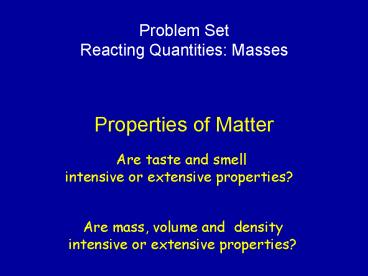Properties of Matter - PowerPoint PPT Presentation
1 / 26
Title:
Properties of Matter
Description:
intensive or extensive properties? Are taste and smell. intensive or extensive properties? ... elements have different properties. mass, size, reactivity, etc. ... – PowerPoint PPT presentation
Number of Views:676
Avg rating:3.0/5.0
Title: Properties of Matter
1
Properties of Matter
Problem Set Reacting Quantities Masses
Are taste and smell intensive or extensive
properties?
Are mass, volume and density intensive or
extensive properties?
2
Chemical Stoichiometry
- Edward A. Mottel
- Department of Chemistry
- Rose-Hulman Institute of Technology
3
Chemical Equations
- Stoichiometry (atom balance)
- Charge (charge balance)
- Format
- Phase annotation (s, l, g, aq)
- Arrow notations
- Reading assignment
- Zumdahl Chapter 2.1-2.4, 3.6-3.7
4
Annotated (g, l, s, aq) Equations
- The phase of a reactant or product is often
important. - gas
- liquid
- solid
- aqueous solution
Write an annotated equation for the decomposition
of a 3 solution of hydrogen peroxide to
give water and oxygen.
5
Things to Think About whenWriting a Chemical
Equation.
- What is the formula of the reactant product?
- What is the phase of the reactant product?
- Does it dissolve?
- What would you observe?
- How could you predict it?
Write an equation for what occurs when solid
sodium hydrogen carbonate is mixed with water.
6
Solid Sodium Hydrogen Carbonate is Mixed with
Water
Does it ionize?
How could you tell?
7
(No Transcript)
8
(No Transcript)
9
Sodium Hydrogen Carbonate
- Why is it called sodium bicarbonate?
10
Nomenclature
- Give two acceptable names
- for each of these ions.
HSO4
HSO3
HS
11
HCl(g) NaHCO3(aq)
NaCl(aq) CO2(g) H2O(l)
- Let
- be oxygen
- Ó be carbon
- Ä be hydrogen
- be sodium
- ? be chlorine
- Rewrite the equation in terms of graphics
How does your chemical equation
demonstrate Daltons atomic theory?
12
Atomic TheoryJohn Dalton (1809)
In a chemical reaction, the way the atoms are
bound together changes, but the atoms dont
change.
13
- Each elemental substance cannot be divided
indefinitely, but is composed of fundamental
subunits called atoms.
- Atoms of different elements have different
properties - mass, size, reactivity, etc.
14
- In chemical reactions, atoms are never
interconverted, created or destroyed.
- Each pure compound contains different elements
which occur in a specific ratio with respect to
one another.
- Chemical changes involve the rearrangement of
atoms.
15
19th Century Chemistry
3 grams of carbon
4 grams of oxygen
Analyzed reactions using weights and volumes
16
Amadeo Avogadro (1811)
- In a fixed volume, at a given temperature and
pressure, every gas contains the same number of
particles (molecules).
Avogadro never heard of the term mole, or
Avogadros Number!
Theory was not accepted for 50 years.
17
Atoms are Small
- Generally measured in atomic mass units (amu) or
daltons - Carbon-12 (6 protons and 6 neutrons) has a mass
of exactly 12.000 amu - The conversion factor from an atomic quantity
(amu) to a measurable quantity (gram) is the mole.
18
A Mole is Big
- One mole equals 6.022 x 1023 units of anything.
- 6.022 x 1023 amu 1.000 mole of amu 1.000 gram
19
Limestone
- Limestone is a naturally occurring material
consisting principally of calcium carbonate. - Upon heating (roasting) at gt1000 C, it
decomposes into calcium oxide (lime) and carbon
dioxide.
You are the chief engineer. How could you
determine when this roasting process is completed?
20
Limestone
- If you began with 1000. grams of limestone, and
the limestone was heated, - what would be the percentage converted when the
mass of solid is 900. grams? - what would be the mass of solid when it is 95
converted?
21
Problem Set Reacting Quantities Masses
22
Hydrogen PeroxideDecomposition
23
Team Peroxide
- With your team "diagram" your approach to solve
the following problem.
24
- Concentrated hydrogen peroxide contains 30
hydrogen peroxide by weight and the balance
water. The density of 30 hydrogen peroxide is
1.110 gmL-1. - Hydrogen peroxide decomposes upon standing, over
a period of several months, to form water and
oxygen. - Assume an empty 500 mL plastic bottle used to
hold hydrogen peroxide has a mass of 100.0 grams.
25
- What would be the difference in mass and the
percentage difference in mass between 500 mL of
fresh 30 hydrogen peroxide in the 500 mL bottle
and a bottle of hydrogen peroxide which is
decomposed? - Assume any oxygen gas formed escapes.
- The density of water at 25.0 C is 0.9970gcm-3.
- The density of pure hydrogen peroxide is 1.442
gcm-3.
26
(No Transcript)































